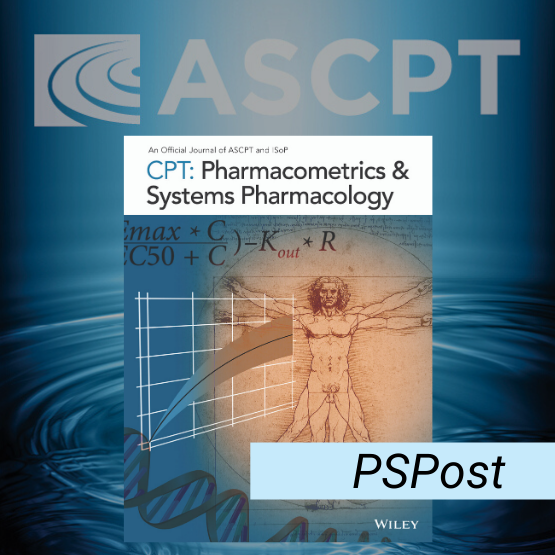Author: Mark Peterson, PhD, CJ Musante, PhD, Piet van der Graaf, PharmD, PhD on April 13, 2017 
Friday, 5 May 2017, 11:00AM-12:00PM EDT (UTC -4)
Modeling and simulation has become an integral and expected part of internal and regulatory decision making, as illustrated by regulatory guidelines and industry best practice guidelines. For example, as a response to a request from the European Medicines Agency (EMA), the European Federation of Pharmaceutical Industries and Associations (EFPIA) recently published a good practice document covering all aspects of planning, conduct and documentation of quantitative approaches across R&D, which they labelled model-based drug discovery and development, or MID3.
However, despite the demonstrable return-on-investment of MID3 across industry, there remains a significant opportunity for a broader and deeper impact. In particular, attrition in late-stage clinical development remains high and is a main factor behind rising R&D costs and continuously challenging Pharma’s ability to bring new medicines to patients. Lack of efficacy or differentiation is by far the main reason for attrition in drug development. Arguably, one of the fundamental origins of such attrition is a lack of quantitative understanding of the complexity of disease biology in diverse patient populations, which makes accurately predicting the impact of perturbing such complex systems with a drug very difficult, in particular with quantitative approaches that are largely empirical and based on statistical principles. Therefore, some 10 years ago quantitative scientists from industry, academia and regulatory agencies started to focus on bringing together the disciplines of pharmacometrics and systems biology, which until then had been operating more or less independently. This resulted in the publication of a White Paper sponsored by National Institute of General Medical Sciences in 2011, which is widely seen as the milestone defining the birth of the discipline of quantitative systems pharmacology (or QSP) as applied to drug discovery and development. In the White Paper, QSP is defined as an approach to translational medicine that combines computational and experimental methods to elucidate, validate and apply new pharmacological concepts to the development and use of small molecule and biologic drugs. QSP aims to provide an integrated “systems level” approach to determining mechanisms of action of new and existing drugs in preclinical models and in patients and therefore creates the knowledge needed to change complex cellular networks in a specified way with mono or combination therapy, alter the pathophysiology of disease so as to maximize therapeutic benefit and minimize toxicity and implement a “precision medicine” approach to improving the health of individual patients.
Traditional empirical PKPD and pharmacometrics models are designed to characterize one or more specific but similar datasets to generate inferences and predict results for related scenarios. QSP models, meanwhile, are designed to investigate the effects of drug action on emergent behaviors of the underlying system and disease. QSP can be regarded as an approach to integrate features of the various model approaches spanning the spectrum between “bottom-up” systems biology and “top-down” pharmacometrics.
At this stage, most large pharmaceutical companies have incorporated QSP into Drug Discovery and Development. For example, a paper published back in 2014 by Merck scientists, provides examples of how QSP has been used in Pharma to facilitate drug development, noting an impact on decision making with a high return on investment. An article published earlier this year by Zineh et al. illustrates where QSP may fit as a tool in the drug development continuum from a regulatory point of view and discusses the value of building pre-competitive QSP models for varying diseases.
While the number of clinical application examples continues to increase, many presentations on the subject are designed for researchers experienced in quantitative methods. However, there is a broader segment of the pharma and biotech community that is interested in understanding the strategic rationale for QSP models in drug development, and how this approach can be used to inform program decisions. In this scientific webinar, members of the IQ Consortium Clinical Pharmacology Leadership Group’s Quantitative Systems Pharmacology Working Group (IQ CPLG QSP WG) present an introduction to QSP, including case study examples that address the following questions:
- What is QSP and what does it bring to drug development beyond PK/PD?
- Who should use it, how to use it, and when to use it in clinical development?
- What impact can it have on development programs?
The International Consortium for Innovation & Quality in Pharmaceutical Development (IQ) is a not-for-profit organization of pharmaceutical and biotechnology companies with the mission of advancing science and technology to augment the capability of member companies to develop transformational solutions that benefit patients, regulators and the broader R&D community. Consistent with this mission, it is the hope of the IQ CPLG QSP WG that this presentation will expand the understanding of the role of QSP in drug development and will lead to further dialogues on the value and application of this approach.
This webinar is free and open to the public. Registration is now closed.

The comment feature is locked by administrator.